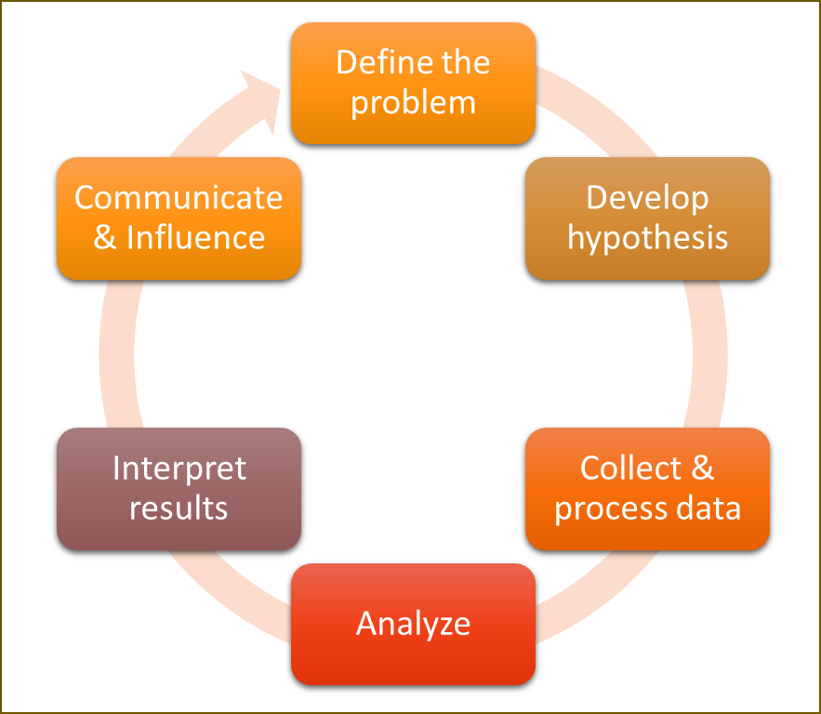Bridging the Gap in the Analytics Value Chain: From Insight to Decision
- Derrick Yuen, MBA

- Jan 26
- 3 min read
Updated: Jan 26

The concept of the analytics value chain is foundational to understanding how organizations can derive actionable insights from data. Rooted in the scientific process, the analytics value chain is not merely a technical exercise; it is a structured approach that begins with a clearly defined question, progresses through data gathering and analysis, and culminates in informed decision-making. Yet, while significant progress has been made in mastering tools and analytical techniques, the most critical gap lies not in data collection or analysis but in translating insights into actionable strategies and presenting them effectively to decision-makers.
The Analytics Value Chain: A Quick Overview

The analytics value chain is often misinterpreted as starting with data, but this is a misconception. The process starts with the right question—a question that is clear, specific, and actionable. Once the question is defined, the next step is to develop a comprehensive set of hypotheses. These hypotheses guide analysts in identifying the data that needs to be collected, processed, and analyzed. The analysis phase seeks to validate or invalidate the hypotheses, producing insights that can inform decision-making.
However, the process doesn’t end with insights. Analysts must interpret these findings in the context of the organization’s objectives, craft actionable recommendations, and communicate these through compelling data stories to leaders who will make the final decisions.
Beyond Data and Analytical Skills
While the importance of technical skills—such as data preparation, statistical modeling, and visualization—cannot be understated, they represent only part of the equation. The ability to ask the right questions, interpret insights with a strategic lens, and translate data into executable plans requires a different set of competencies, including:
Critical Thinking: Understanding the broader context and connecting insights to organizational goals.
Systems Thinking: Recognizing the interdependencies within organizational processes and external factors.
Influence and Communication: Persuading stakeholders and facilitating consensus on the best course of action.
The Largest Gap: From Insights to Actionable Options

The biggest challenge in the analytics value chain is not producing insights but bridging the gap between insights and decisions. Walmart’s experience during Hurricane Frances in 2004 provides a compelling example. When faced with significant lost revenue due to stockouts during hurricanes, Walmart’s question was simple yet profound: What do customers demand during a hurricane?
To answer this, analysts examined purchasing data from previous hurricanes, comparing it against regular purchasing patterns. The analysis revealed that items like Strawberry Pop-Tarts and beer were in high demand before hurricanes. However, identifying these items was only the beginning.
The more significant challenge was determining how to operationalize these insights. Walmart needed to devise a supply chain strategy that ensured these products were stocked in stores in hurricane-prone areas at the right time. This required:
Developing a detailed, actionable plan to redistribute inventory.
Aligning supply chain and logistics teams to execute the plan efficiently.
Presenting the business case in a concise, coherent, and compelling manner to decision-makers.
Presenting Insights for Decision-Making
The ability to present insights effectively is as critical as the analysis itself. A successful presentation of data insights should:
Control the Narrative: Start with the intended message or recommendation and build the data story around it.
Provide Context: Explain the problem and the potential consequences of inaction.
Offer Clear Options: Translate data insights into actionable recommendations, presenting the pros and cons of each.
Be Concise and Visual: Use clear visualizations and avoid overwhelming stakeholders with unnecessary details.
In Walmart’s case, analysts presented their findings and recommendations to decision-makers in a manner that facilitated swift and effective decisions. The result was a preemptive supply chain plan that positioned Walmart as the go-to retailer during hurricanes, significantly boosting both revenue and customer satisfaction.
Closing the Gap in Analytics
As the demand for data analytics grows, organizations must recognize that the true value of analytics lies not in the data or tools but in the ability to bridge the gap between insights and decision-making. This requires investment in developing not only technical expertise but also critical thinking, communication, and storytelling skills. By addressing this gap, organizations can ensure that their data-driven strategies are not only insightful but also impactful, driving meaningful outcomes in an increasingly complex world.
Work with Experts Who Understand the Entire Analytics Value Chain
If your organization is looking to bridge the gap between data insights and actionable decision-making, FYT Consulting can help. Our consultants bring deep expertise across the entire analytics value chain—from problem definition to data storytelling—to ensure your organization achieves measurable outcomes. Contact us today to work with a partner who intimately understands these nuances and can help you unlock the full potential of your data.































Comments